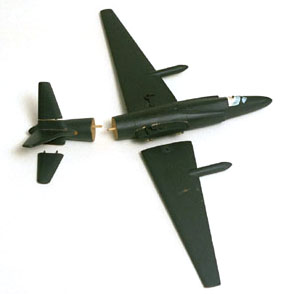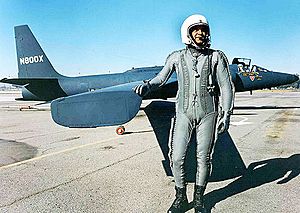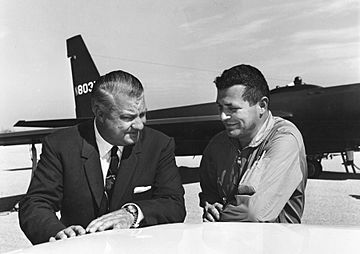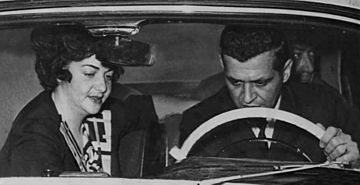Francis Gary Powers facts for kids
Quick facts for kids
Francis Gary Powers
|
|
|---|---|
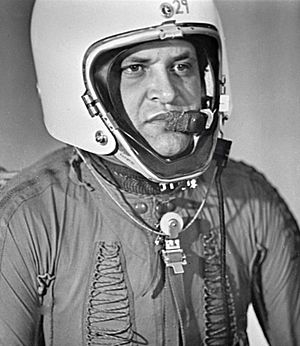
Powers wearing special
pressure suit for stratospheric flying, 1960 |
|
| Born |
Francis Gary Powers
August 17, 1929 Jenkins, Kentucky, U.S.
|
| Died | August 1, 1977 (aged 47) Los Angeles, California, U.S.
|
| Cause of death | Helicopter crash |
| Resting place | Arlington National Cemetery |
| Known for | 1960 U-2 incident |
| Spouse(s) |
Barbara Gay Moore
(m. 1956; div. 1963)Claudia Edwards Downey
(m. 1963) |
| Awards | Director's Award |
| Aviation career | |
| Rank | |
Francis Gary Powers (born August 17, 1929 – died August 1, 1977) was an American pilot. He worked for the Central Intelligence Agency (CIA). His Lockheed U-2 spy plane was shot down over the Soviet Union. This event led to the famous 1960 U-2 incident.
After this, he became a helicopter pilot for a TV station in Los Angeles. He died in a helicopter crash in 1977.
Contents
Early Life and Military Service
Francis Gary Powers was born in Jenkins, Kentucky, on August 17, 1929. His father was a coal miner. The family later moved to Pound, Virginia. Gary was the only boy among six children.
His father wanted him to become a doctor. He hoped Gary would have an easier life than working in a mining town.
Education and Joining the Air Force
Powers earned a degree from Milligan College in Tennessee in 1950. In October of that year, he joined the United States Air Force. He became a second lieutenant in 1952 after finishing pilot training. He then flew Republic F-84 Thunderjet planes.
In 1955, he married Barbara Gay Moore.
Joining the CIA
In January 1956, the CIA recruited Powers. He began training to fly the U-2 spy plane in May 1956. His training was completed by August 1956. His unit was sent to Incirlik Air Base in Turkey.
By 1960, Powers had flown many secret spy missions. His family thought he was a NASA pilot who studied weather.
The U-2 Incident
Powers left the Air Force in 1956 as a captain. He then joined the CIA's Lockheed U-2 program. U-2 pilots flew spy missions very high up, at about 70,000 feet (21 km). This was thought to be too high for Soviet defenses to reach.
The U-2 had a special camera. It took clear photos from high in the stratosphere over countries like the Soviet Union. These U-2 missions took pictures of military bases and other important places.
The Spy Mission
The main goal of the U-2 planes was to fly over the Soviet Union. Soviet intelligence knew about these flights since 1958. But they could not stop them until 1960. On May 1, 1960, Powers's U-2 plane took off from Peshawar, Pakistan. This flight was meant to go all the way across the Soviet Union. It would pass over important places that had never been photographed before.
Shot Down Over Soviet Territory
Powers's plane was shot down by a missile over Sverdlovsk. The missile was an S-75 Dvina (SA-2 "Guideline"). Many missiles were launched. One of them hit a Soviet jet fighter that was trying to stop the U-2. Its pilot died.
As Powers flew, three missiles were fired at his U-2. The first one hit his plane. The plane started spinning upside down. Powers could not activate the camera's self-destruct system. He was thrown out of the plane after releasing his seat belt.
While floating down with his parachute, Powers scattered his escape map. He landed hard and was quickly captured. He was taken to Lubyanka Prison in Moscow.
U.S. Government's Cover-Up
When the U.S. government learned Powers was missing, they said a "weather plane" had gone off course. They claimed the pilot had problems with his oxygen. But CIA officials did not know that the plane crashed mostly in one piece. The Soviets had found the plane and its secret camera.
Powers was questioned by the KGB (Soviet secret police) for months. He later confessed to spying and apologized publicly.
How Powers Was Seen in U.S. Media
After the White House admitted Powers was captured, American news showed him as a hero. The CIA told his wife what to say to the press. She was told to act like a devoted wife.
But after Powers apologized at his trial, some American news outlets changed their view. They sometimes called him a coward.
Powers tried to keep information from the KGB. He only shared what they could find from the plane's wreckage. But news reports from the West made it harder for him. A KGB officer told him, "Your Press will give it to us."
Powers did limit what he told them about CIA contacts. He also kept saying the U-2's maximum altitude was lower than it actually was.
Political Impact of the Incident
The U-2 incident caused problems between Soviet leader Khrushchev and U.S. President Eisenhower. Powers's questioning ended on June 30. His trial for spying began on August 17, 1960. His parents, sister, wife, and her mother were there.
Powers's Conviction
On August 19, 1960, Powers was found guilty of spying. He was sentenced to 10 years in prison. Three of those years would be in a prison, and the rest in a labor camp. The U.S. Embassy said he would still get his full salary while in prison.
He was held in Vladimir Central Prison, east of Moscow. He was there from September 1960 to February 1962. He kept a diary and learned carpet weaving. He could send and receive letters from his family. Parts of his plane and uniform are now in a museum near Moscow.
Prisoner Exchange
The CIA at first did not want to trade Powers. Some thought he might have joined the Soviet side. They also thought he had already told the Soviets everything he knew.
However, President John F. Kennedy approved the exchange. On February 10, 1962, Powers was exchanged for a Soviet KGB officer named Rudolf Abel. The exchange happened on the Glienicke Bridge in Germany. Powers had been held for 1 year, 9 months, and 10 days.
After His Return
When Powers returned home, some people were critical. They said he should have destroyed his plane's camera and secret parts.
The CIA, Lockheed, and the Air Force questioned him. The CIA director said Powers "lived up to the terms of his employment and instructions." In March 1962, he spoke to a Senate committee. Senators praised him for his courage and loyalty.
Family Life After Release
Powers and his first wife, Barbara, separated in 1962 and divorced in 1963. He then met Claudia Edwards "Sue" Downey. They married on October 26, 1963. Their son, Francis Gary Powers Jr., was born in 1965. Their marriage was very happy. Sue worked to protect her husband's memory after he died.
Later Work
Powers worked for Lockheed as a test pilot from 1962 to 1970. The CIA paid his salary. In 1970, he wrote a book called Operation Overflight. Lockheed then fired him because the book caused problems at the CIA.
After that, Powers became a traffic reporter. He flew a plane for a Los Angeles radio station. Later, he became a helicopter news reporter for KNBC television.
Death
On August 1, 1977, Powers was flying a helicopter for KNBC Channel 4. He was reporting on brush fires in Santa Barbara County. The helicopter crashed in Encino, California, killing him and his cameraman, George Spears.
His helicopter ran out of fuel. The official report said the crash was due to pilot error. Powers's son said that a mechanic had fixed a faulty fuel gauge without telling Powers. This might have caused Powers to misread it.
It is believed that Powers saw children playing below. He changed the helicopter's path to avoid landing on them. This last-second change might have prevented him from landing safely. Powers was buried in Arlington National Cemetery.
Honors and Legacy
 |
||
| USAF Senior Pilot Badge | ||
| Silver Star | Distinguished Flying Cross | Intelligence Star (Valor Award) |
| Prisoner of War Medal | Army Good Conduct Medal | National Defense Service Medal with 1 bronze service star |
| Korean Service Medal | Air Force Longevity Service Award with two bronze oak leaf clusters |
United Nations Service Medal for Korea |
Powers received the CIA's Intelligence Star in 1965. This award was for his bravery. It was supposed to be given earlier, but it was delayed for political reasons.
In 1998, new information showed that Powers's mission was a joint Air Force/CIA operation. In 2000, on the 40th anniversary of the U-2 Incident, his family received several awards for him. These included the Prisoner of War Medal, Distinguished Flying Cross, and National Defense Service Medal. The CIA Director also gave Powers the Director's Medal for his loyalty and courage.
On June 15, 2012, Powers was given the Silver Star medal after his death. This was for his "exceptional loyalty" during his harsh questioning in prison. His grandchildren received the award at a ceremony.
Powers's Legacy
Powers's son, Francis Gary Powers Jr., started the Cold War Museum in 1996. This museum is connected to the Smithsonian Institution. It helps people learn about the Cold War and his father's story.
See also
 In Spanish: Francis Gary Powers para niños
In Spanish: Francis Gary Powers para niños



